Photodynamic and Antibacterial Assessment of Gold Nanoparticles Mediated by Gold (III) Chloride Trihydrate and Sodium Citrate under Alkaline Conditions
Abstract
1. Introduction
2. Methods and Materials
2.1. Reagents
2.2. Photolytic Reaction Setup
2.3. Influence of Colored Light on the Development of AuNPs
2.4. Effect of GC, SC, GCSC, and D—AuNPs on E. coli under VLI
2.5. Effects of GCSC on E. coli under Colored Light Illumination
2.6. Observation of
2.7. Detection Using GCSC-Treated E. coli Subjected to BLI or VLI
2.8. Statistics
3. Results and Discussion
3.1. The Alternation of Citrate Mixed with Gold (III) Ions under Colored Light Illumination
3.2. Detection in SC and GCSC under VLI Treatment
Citrate Acetone-1,3-dicarboxylate
3.3. Effect of GCSC Exposed to Colored Light on E. coli Survival
3.4. Effects of GC, SC, GCSC, and D--AuNPs on E. coli Survival When Subjected to VLI
3.5. Detection in GCSC-Treated E. coli Subjected to BLI or VLI
4. Conclusions
Author Contributions
Funding
Institutional Review Board Statement
Informed Consent Statement
Data Availability Statement
Acknowledgments
Conflicts of Interest
Abbreviations
| aPDI | antibacterial photodynamic inactivation |
| AuNPs | gold nanoparticles |
| CFUs | viable plate colony counts |
| D--AuNPs | four-fold diluted AuNPs suspensions |
| E. coli | Escherichia coli |
| GC | 0.1 mM gold (III) chloride trihydrate in PBS |
| GCSC | GC upon addition of the SC |
| NBT | nitrotetrazolium blue chloride |
| anionic superoxide radicals | |
| PBS | 0.1 M potassium phosphate buffer at pH 7.8 |
| ROS | reactive oxygen species |
| SC | 4.53 mM sodium citrate in PBS |
| SPR | surface plasmon resonance |
| TEM | transmission electron microscopy |
| VLI | violet light illumination in phosphate buffered solution at pH 7.8 |
References
- Al Gharib, S.; Marignier, J.L.; El Omar, A.K.; Naja, A.; Le Caer, S.; Mostafavi, M.; Belloni, J. Key role of the oxidized citrate-free radical in the nucleation mechanism of the metal nanoparticle Turkevich synthesis. J. Phys. Chem. C 2019, 123, 22624–22633. [Google Scholar] [CrossRef]
- Pasparakis, G. Light-induced generation of singlet oxygen by naked gold nanoparticles and its implications to cancer cell phototherapy. Small 2013, 9, 4130–4134. [Google Scholar] [CrossRef] [PubMed]
- Mejía-Méndez, J.L.; López-Mena, E.R.; Sánchez-Arreola, E. Activities against lung cancer of biosynthesized silver nanoparticles: A review. Biomedicines 2023, 11, 389. [Google Scholar] [CrossRef] [PubMed]
- Mahmood, R.I.; Kadhim, A.A.; Ibraheem, S.; Albukhaty, S.; Mohammed-Salih, H.S.; Abbas, R.H.; Jabir, M.S.; Mohammed, M.K.A.; Nayef, U.M.; AlMalki, F.A.; et al. Biosynthesis of copper oxide nanoparticles mediated Annona muricata as cytotoxic and apoptosis inducer factor in breast cancer cell lines. Sci. Rep. 2022, 12, 16165. [Google Scholar] [CrossRef] [PubMed]
- Jabir, M.S.; Rashid, T.M.; Nayef, U.M.; Albukhaty, S.; AlMalki, F.A.; Albaqami, J.; AlYamani, A.A.; Taqi, Z.J.; Sulaiman, G.M. Inhibition of Staphylococcus aureus α-hemolysin production using canocurcumin Capped Au@ZnO nanocomposite. Bioinorg. Chem. Appl. 2022, 1, 2663812. [Google Scholar]
- Oliveira, A.E.F.; Pereira, A.C.; Resende, M.A.; Ferreira, L.F. Gold Nanoparticles: A didactic step-by-step of the synthesis using the turkevich method, mechanisms, and characterizations. Analytica 2023, 4, 250–263. [Google Scholar] [CrossRef]
- Jin, R.; Cao, Y.; Mirkin, C.A.; Kelly, K.L.; Schatz, G.C.; Zheng, J. Photoinduced conversion of silver nanospheres to nanoprisms. Science 2001, 294, 1901–1903. [Google Scholar] [CrossRef]
- Yang, L.C.; Lai, Y.S.; Tsai, C.M.; Kong, Y.T.; Lee, C.I.; Huang, C.L. One-pot synthesis of monodispersed silver nanodecahedra with optimal SERS activities using seedless photo-assisted citrate reduction method. J. Phys. Chem. C 2012, 116, 24292–24300. [Google Scholar] [CrossRef]
- Yang, L.C.; Huang, C.L.; Liao, C.H.; Lee, Y.C. Manufacturing Method of Precious Metal Nanoparticles. Taiwan Patent No. TW201330955A, 1 August 2013. [Google Scholar]
- Tadesse, D.A.; Zhao, S.; Tong, E.; Ayers, S.; Singh, A.; Bartholomew, M.J.; McDermott, P.F. Antimicrobial drug resistance in Escherichia coli from humans and food animals, United States, 1950–2002. Emerg. Infect. Dis. 2012, 18, 741–749. [Google Scholar] [CrossRef]
- von Baum, H.; Marre, R. Antimicrobial resistance of Escherichia coli and therapeutic implications. Int. J. Med. Microbiol. 2005, 295, 503–511. [Google Scholar] [CrossRef]
- Xie, L.J.; Wang, R.L.; Wang, D.; Liu, L.; Cheng, L. Visible-light-mediated oxidative demethylation of N(6)-methyl adenines. Chem. Commun. 2017, 53, 10734–10737. [Google Scholar] [CrossRef] [PubMed]
- Tim, M. Strategies to optimize photosensitizers for photodynamic inactivation of bacteria. J. Photochem. Photobiol. B Biol. 2015, 150, 2–10. [Google Scholar] [CrossRef] [PubMed]
- Cheng, C.W.; Chen, L.Y.; Chou, C.W.; Liang, J.Y. Investigations of riboflavin photolysis via coloured light in the nitro blue tetrazolium assay for superoxide dismutase activity. J. Photochem. Photobiol. B Biol. 2015, 148, 262–267. [Google Scholar] [CrossRef]
- Cheng, C.W.; Lee, S.Y.; Chen, T.Y.; Yuann, J.M.P.; Chiu, C.M.; Huang, S.T.; Liang, J.Y. Inactivation of pathogens via visible-light photolysis of riboflavin-5′-phosphate. JoVE 2022, 182, e63531. [Google Scholar]
- Yuann, J.M.P.; Lee, S.Y.; Yang, M.J.; Huang, S.T.; Cheng, C.W.; Liang, J.Y. A study of catechin photostability using photolytic processing. Processes 2021, 9, 293. [Google Scholar] [CrossRef]
- Huang, S.T.; Wu, C.Y.; Lee, N.Y.; Cheng, C.W.; Yang, M.J.; Hung, Y.A.; Wong, T.W.; Liang, J.Y. Effects of 462 nm light-emitting diode on the inactivation of Escherichia coli and a multidrug-resistant by tetracycline photoreaction. J. Clin. Med. 2018, 7, 278. [Google Scholar] [CrossRef] [PubMed]
- Yuann, J.M.P.; Lee, S.Y.; He, S.; Wong, T.W.; Yang, M.J.; Cheng, C.W.; Huang, S.T.; Liang, J.Y. Effects of free radicals from doxycycline hyclate and minocycline hydrochloride under blue light irradiation on the deactivation of Staphylococcus aureus, including a methicillin-resistant strain. J. Photochem. Photobiol. B Biol. 2022, 226, 112370. [Google Scholar] [CrossRef]
- Misawa, M.; Takahashi, J. Generation of reactive oxygen species induced by gold nanoparticles under X-ray and UV irradiations. Nanomedicine 2011, 7, 604–614. [Google Scholar] [CrossRef]
- Vankayala, R.; Sagadevan, A.; Vijayaraghavan, P.; Kuo, C.L.; Hwang, K.C. Metal nanoparticles sensitize the formation of singlet oxygen. Angew. Chem. Int. Ed. 2011, 50, 10640–10644. [Google Scholar] [CrossRef]
- Chadwick, S.J.; Salah, D.; Livesey, P.M.; Brust, M.; Volk, M. Singlet oxygen generation by laser irradiation of gold nanoparticles. J. Phys. Chem. C 2016, 120, 10647–10657. [Google Scholar] [CrossRef]
- Zhang, Y.; Shareena Dasari, T.P.; Deng, H.; Yu, H. Antimicrobial activity of gold nanoparticles and ionic gold. J. Environ. Sci. Health C Environ. Carcinog. Ecotoxicol. Rev. 2015, 33, 286–327. [Google Scholar] [CrossRef]
- Dasari, T.S.; Zhang, Y.; Yu, H. Antibacterial activity and cytotoxicity of gold (I) and (III) ions and gold nanoparticles. Biochem. Pharmacol. 2015, 4, 199. [Google Scholar] [CrossRef]
- Wang, S.; Lawson, R.; Ray, P.C.; Yu, H. Toxic effects of gold nanoparticles on Salmonella typhimurium bacteria. Toxicol. Ind. Health. 2011, 27, 547–554. [Google Scholar] [CrossRef]
- Cheng, C.W.; Lee, S.Y.; Zhan, S.Q.; Huang, C.L.; Chen, T.Y.; Yuann, J.M.P.; Huang, S.T.; Chiu, C.M.; Liang, J.Y. The effect of photolysis of sodium citrate treated with gold chloride using coloured light on the generation of gold nanoparticles and the repression of WiDr colon cancer cells. J. Photochem. Photobiol. B Biol. 2024, 251, 112844. [Google Scholar] [CrossRef]
- Cheng, C.W.; Lee, S.Y.; Chen, T.Y.; Yang, M.J.; Yuann, J.M.P.; Chiu, C.M.; Huang, S.T.; Liang, J.Y. A study of the effect of reactive oxygen species induced by violet and blue light from oxytetracycline on the deactivation of Escherichia coli. Photodiagnosis Photodyn. Ther. 2022, 39, 102917. [Google Scholar] [CrossRef]
- Yang, J.; Cao, Y.; Zhang, N. Spectrophotometric method for superoxide anion radical detection in a visible light (400–780 nm) system. Spectrochim. Acta A Mol. Biomol. Spectrosc. 2020, 239, 118556. [Google Scholar] [CrossRef]
- Kumar, S.; Gandhi, K.; Kumar, R. Modeling of formation of gold nanoparticles by citrate method. Ind. Eng. Chem. Res. 2007, 46, 3128–3136. [Google Scholar] [CrossRef]
- Gao, Y.; Torrente-Murciano, L. Mechanistic insights of the reduction of gold salts in the Turkevich protocol. Nanoscale 2020, 12, 2740–2751. [Google Scholar] [CrossRef]
- Frens, G. Controlled nucleation for the regulation of the particle size in monodisperse gold suspensions. Nat. Phys. Sci. 1973, 241, 20–22. [Google Scholar] [CrossRef]
- Pinho, B.; Torrente-Murciano, L. Continuous manufacturing of silver nanoparticles between 5 and 80 nm with rapid online optical size and shape evaluation. React. Chem. Eng. 2020, 5, 342–355. [Google Scholar] [CrossRef]
- Shi, L.; Buhler, E.; Boué, F.; Carn, F. How does the size of gold nanoparticles depend on citrate to gold ratio in Turkevich synthesis? Final answer to a debated question. J. Colloid Interface Sci. 2017, 492, 191–198. [Google Scholar] [CrossRef]
- Wu, K.J.; Bohan, G.M.D.V.; Torrente-Murciano, L. Synthesis of narrow sized silver nanoparticles in the absence of capping ligands in helical microreactors. React. Chem. Eng. 2017, 2, 116–128. [Google Scholar] [CrossRef]
- Dou, J.; Alpert, P.A.; Corral Arroyo, P.; Luo, B.; Schneider, F.; Xto, J.; Huthwelker, T.; Borca, C.N.; Henzler, K.D.; Raabe, J. Photochemical degradation of iron (III) citrate/citric acid aerosol quantified with the combination of three complementary experimental techniques and a kinetic process model. Atmos. Chem. Phys. 2021, 21, 315–338. [Google Scholar] [CrossRef]
- Weller, C.; Horn, S.; Herrmann, H. Photolysis of Fe (III) carboxylato complexes: Fe (II) quantum yields and reaction mechanisms. J. Photochem. Photobiol. A Chem. 2013, 268, 24–36. [Google Scholar] [CrossRef]
- Wong, T.W.; Cheng, C.W.; Hsieh, Z.J.; Liang, J.Y. Effects of blue or violet light on the inactivation of Staphylococcus aureus by riboflavin-5′-phosphate photolysis. J. Photochem. Photobiol. B Biol. 2017, 173, 672–680. [Google Scholar] [CrossRef]
- Barneck, M.D.; Rhodes, N.L.; de la Presa, M.; Allen, J.P.; Poursaid, A.E.; Nourian, M.M.; Firpo, M.A.; Langell, J.T. Violet 405-nm light: A novel therapeutic agent against common pathogenic bacteria. J. Surg. Res. 2016, 206, 316–324. [Google Scholar] [CrossRef]
- Maclean, M.; MacGregor, S.J.; Anderson, J.G.; Woolsey, G. High-intensity narrow-spectrum light inactivation and wavelength sensitivity of Staphylococcus aureus. FEMS Microbiol. Lett. 2008, 285, 227–232. [Google Scholar] [CrossRef]
- Núñez-Álvarez, C.; Suárez-Barrio, C.; del Olmo Aguado, S.; Osborne, N.N. Blue light negatively affects the survival of ARPE 19 cells through an action on their mitochondria and blunted by red light. Acta. Ophthalmol. 2019, 97, e103–e115. [Google Scholar] [CrossRef]
- Huang, L.; Wang, C.; Xu, H.; Peng, G. Targeting citrate as a novel therapeutic strategy in cancer treatment. Biophys. Acta Rev. Cancer 2020, 1873, 188332. [Google Scholar] [CrossRef]
- Barry Halliwell, J.M.C.G. Oxidative stress: Adaptation, damage, repair and death. In Free Radicals in Biology and Medicine; Oxford University Press Inc.: New York, NY, USA, 2003; pp. 246–350. [Google Scholar]
- Nhung, N.T.; Thuy, C.T.; Trung, N.V.; Campbell, J.; Baker, S.; Thwaites, G.; Hoa, N.T.; Carrique-Mas, J. Induction of antimicrobial resistance in Escherichia coli and non-typhoidal Salmonella strains after adaptation to disinfectant commonly used on farms in Vietnam. Antibiotics 2015, 4, 480–494. [Google Scholar] [CrossRef]
- Yin, R.; Dai, T.; Avci, P.; Jorge, A.E.; de Melo, W.C.; Vecchio, D.; Huang, Y.Y.; Gupta, A.; Hamblin, M.R. Light based anti-infectives: Ultraviolet C irradiation, photodynamic therapy, blue light, and beyond. Curr. Opin. Pharmacol. 2013, 13, 731–762. [Google Scholar] [CrossRef]
- Hamblin, M.R. Antimicrobial photodynamic inactivation: A bright new technique to kill resistant microbes. Curr. Opin. Microbiol. 2016, 33, 67–73. [Google Scholar] [CrossRef]
- Wong, T.W.; Wu, E.C.; Ko, W.C.; Lee, C.C.; Hor, L.I.; Huang, I.H. Photodynamic inactivation of methicillin-resistant Staphylococcus aureus by indocyanine green and near infrared light. Dermatol. Sin. 2018, 36, 8–15. [Google Scholar] [CrossRef]
- Maisch, T.; Hackbarth, S.; Regensburger, J.; Felgentrager, A.; Baumler, W.; Landthaler, M.; Roder, B. Photodynamic inactivation of multi-resistant bacteria (PIB)—A new approach to treat superficial infections in the 21st century. J. Dtsch. Dermatol. Ges. 2011, 9, 360–366. [Google Scholar] [CrossRef]
- Yang, M.J.; Hung, Y.A.; Wong, T.W.; Lee, N.Y.; Yuann, J.M.; Huang, S.T.; Wu, C.Y.; Chen, I.Z.; Liang, J.Y. Effects of blue-light-Induced free radical formation from catechin hydrate on the inactivation of Acinetobacter baumannii, including a carbapenem-resistant strain. Molecules 2018, 23, 1631. [Google Scholar] [CrossRef]
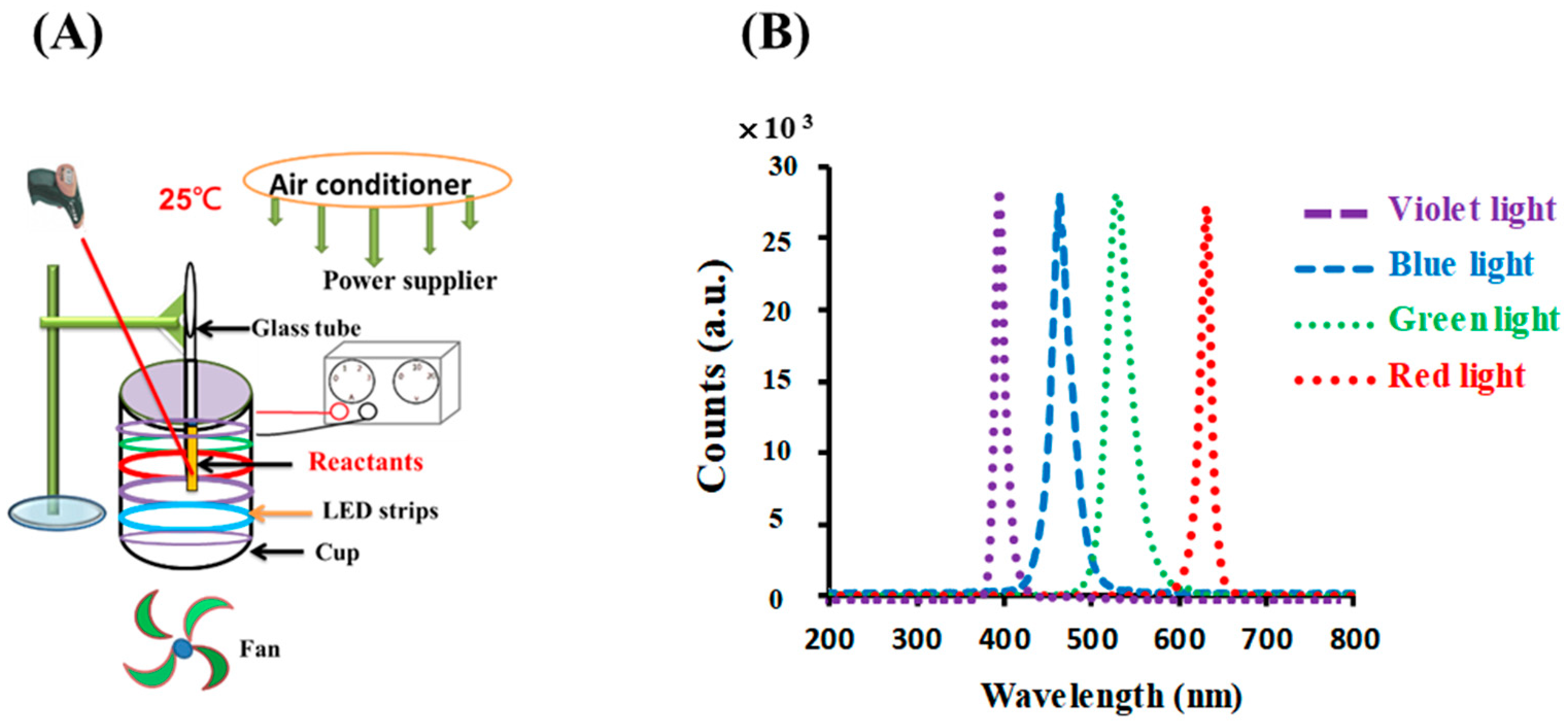

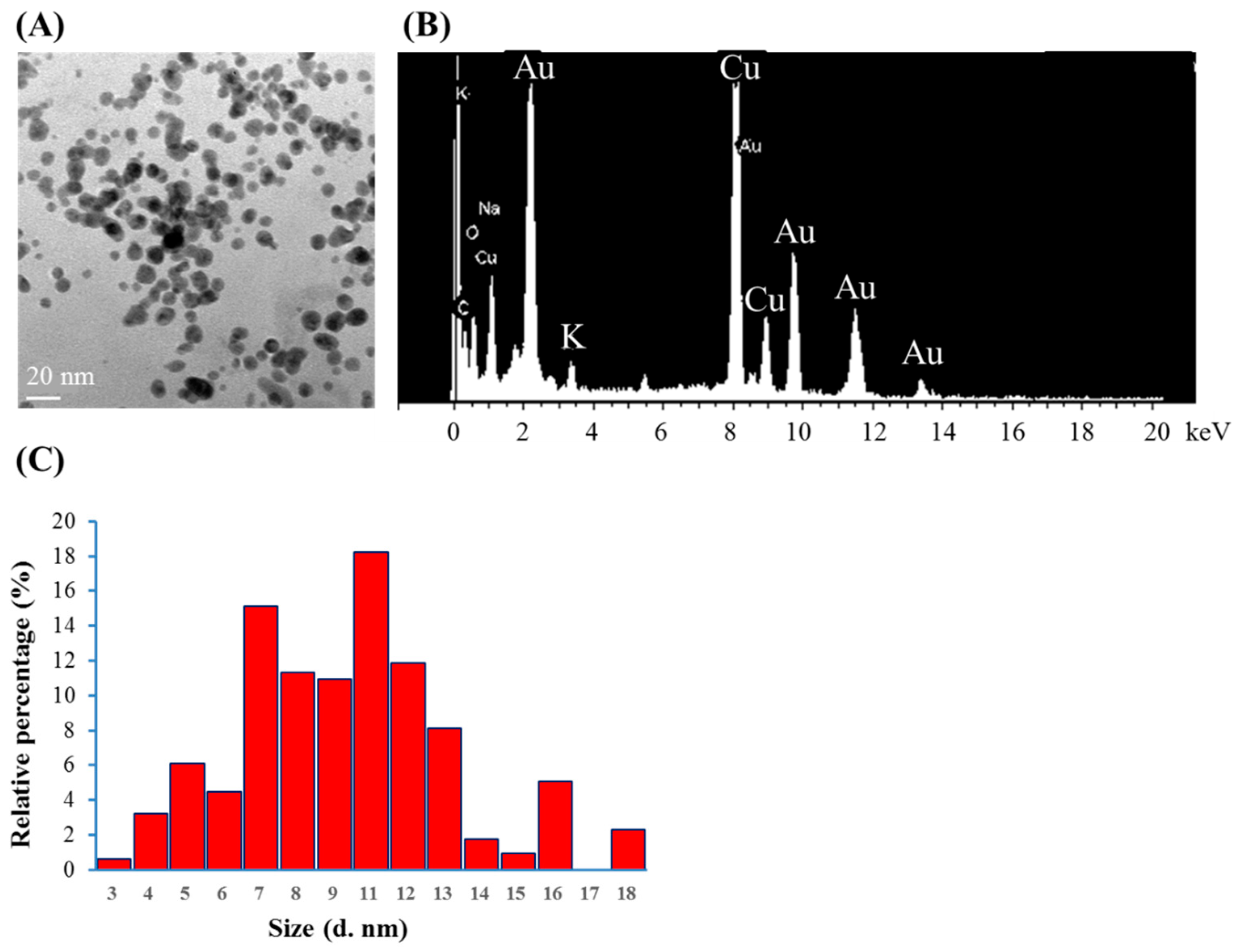


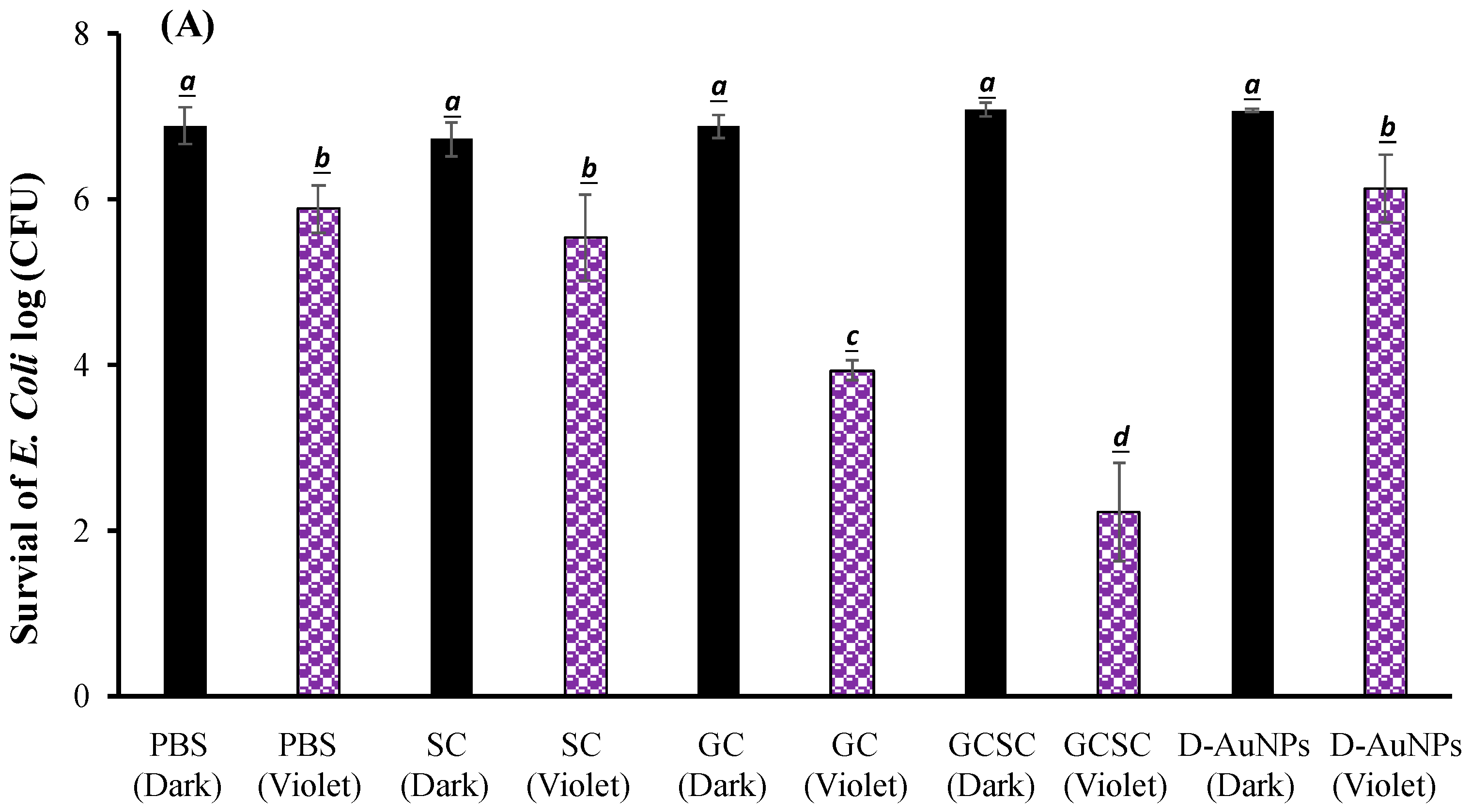
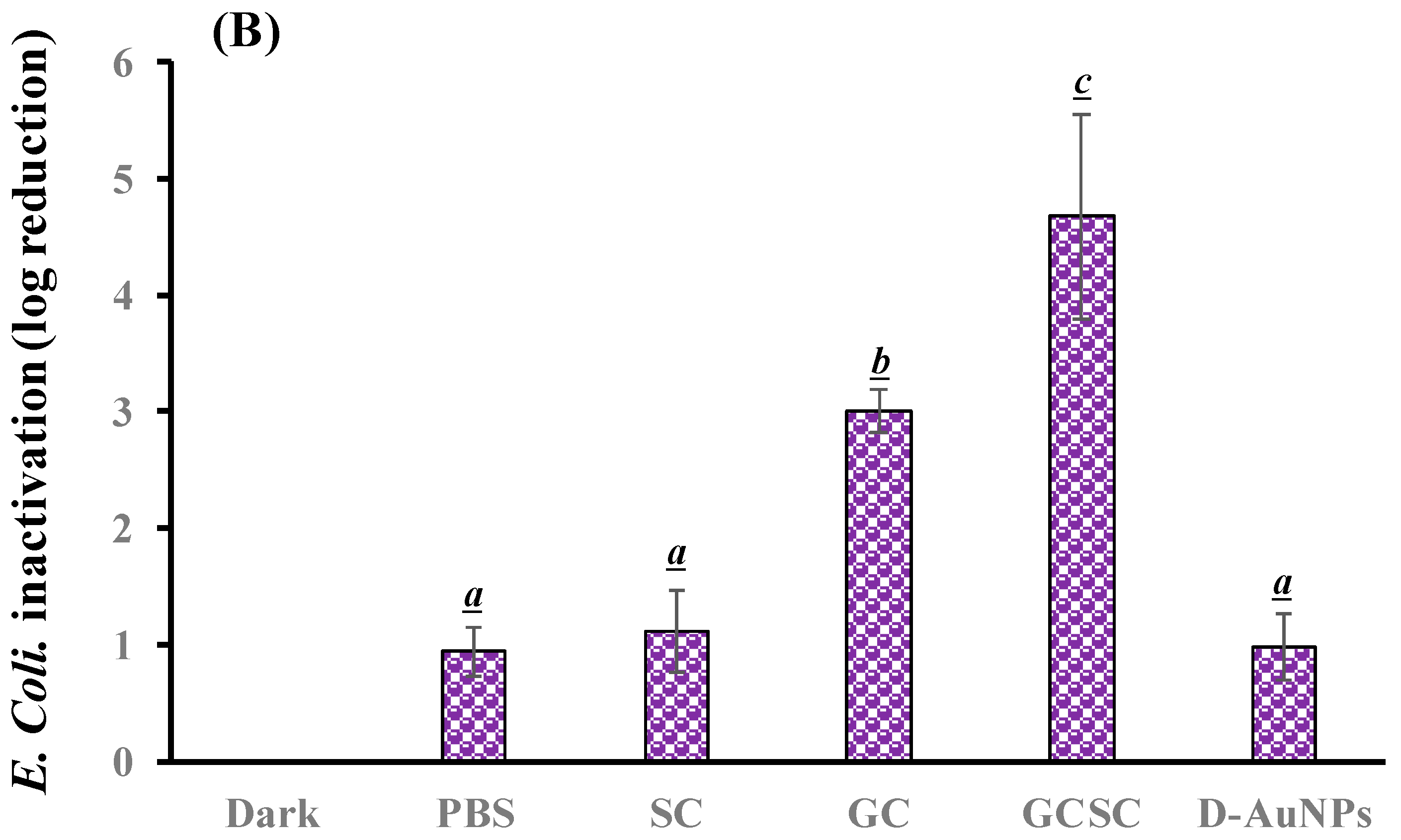
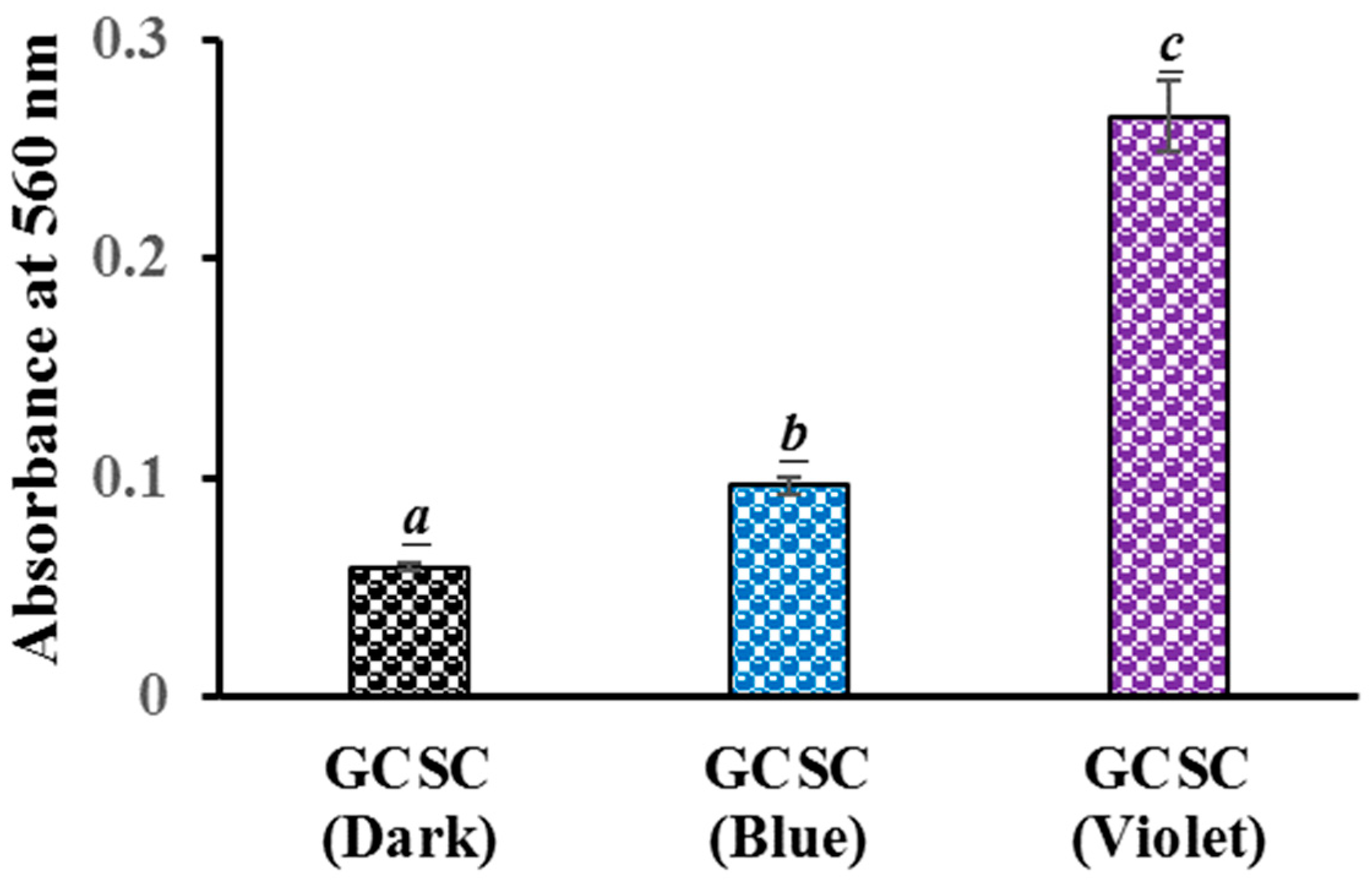
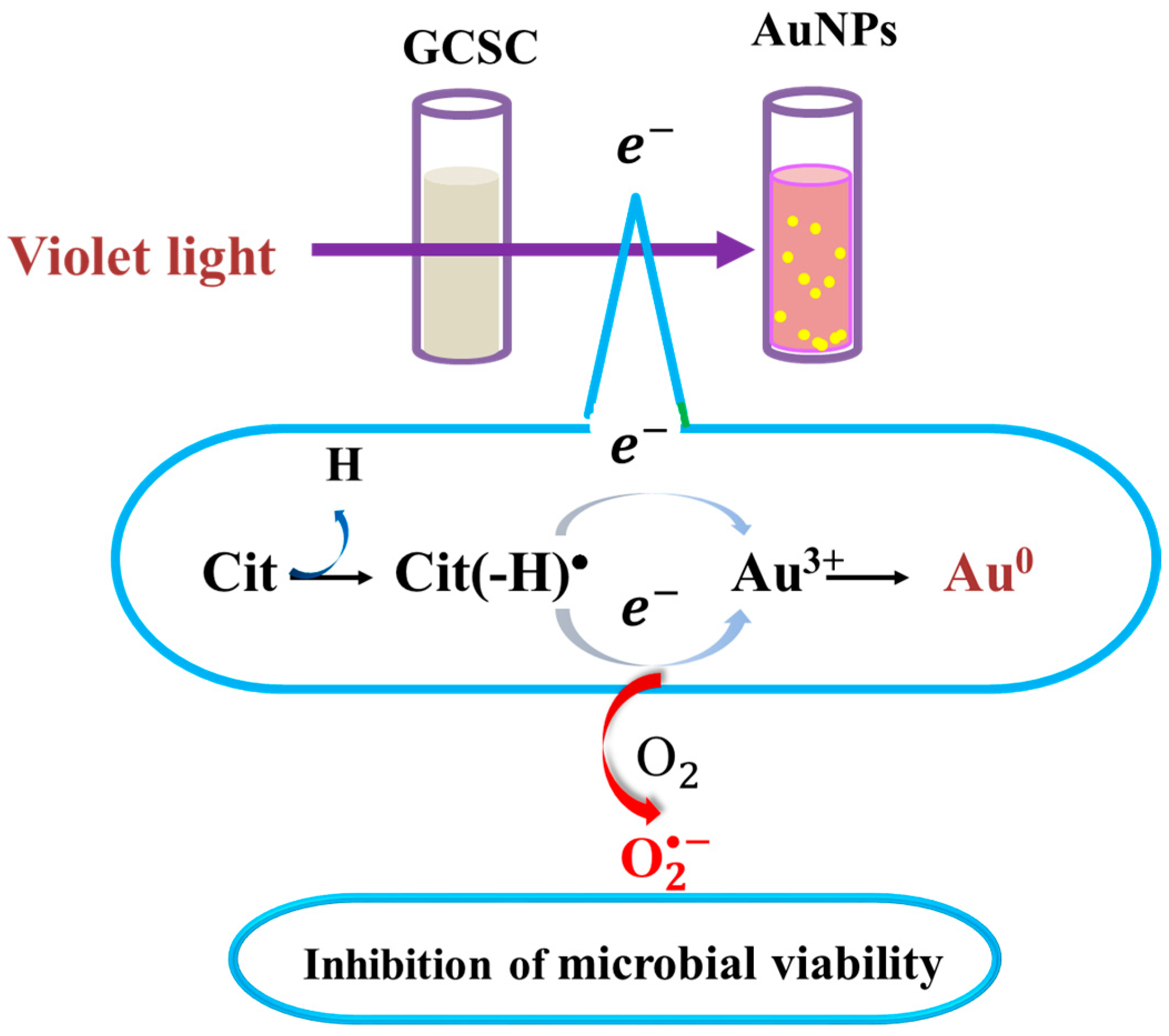
Disclaimer/Publisher’s Note: The statements, opinions and data contained in all publications are solely those of the individual author(s) and contributor(s) and not of MDPI and/or the editor(s). MDPI and/or the editor(s) disclaim responsibility for any injury to people or property resulting from any ideas, methods, instructions or products referred to in the content. |
© 2024 by the authors. Licensee MDPI, Basel, Switzerland. This article is an open access article distributed under the terms and conditions of the Creative Commons Attribution (CC BY) license (https://creativecommons.org/licenses/by/4.0/).
Share and Cite
Cheng, C.-W.; Lee, S.-Y.; Chen, T.-Y.; Chen, C.-C.; Tsai, H.-T.; Huang, H.-H.; Yuann, J.-M.P.; Liang, J.-Y. Photodynamic and Antibacterial Assessment of Gold Nanoparticles Mediated by Gold (III) Chloride Trihydrate and Sodium Citrate under Alkaline Conditions. Materials 2024, 17, 3157. https://doi.org/10.3390/ma17133157
Cheng C-W, Lee S-Y, Chen T-Y, Chen C-C, Tsai H-T, Huang H-H, Yuann J-MP, Liang J-Y. Photodynamic and Antibacterial Assessment of Gold Nanoparticles Mediated by Gold (III) Chloride Trihydrate and Sodium Citrate under Alkaline Conditions. Materials. 2024; 17(13):3157. https://doi.org/10.3390/ma17133157
Chicago/Turabian StyleCheng, Chien-Wei, Shwu-Yuan Lee, Tang-Yu Chen, Ching-Chuan Chen, Hsien-Tsung Tsai, Hsuan-Han Huang, Jeu-Ming P. Yuann, and Ji-Yuan Liang. 2024. "Photodynamic and Antibacterial Assessment of Gold Nanoparticles Mediated by Gold (III) Chloride Trihydrate and Sodium Citrate under Alkaline Conditions" Materials 17, no. 13: 3157. https://doi.org/10.3390/ma17133157
APA StyleCheng, C.-W., Lee, S.-Y., Chen, T.-Y., Chen, C.-C., Tsai, H.-T., Huang, H.-H., Yuann, J.-M. P., & Liang, J.-Y. (2024). Photodynamic and Antibacterial Assessment of Gold Nanoparticles Mediated by Gold (III) Chloride Trihydrate and Sodium Citrate under Alkaline Conditions. Materials, 17(13), 3157. https://doi.org/10.3390/ma17133157






